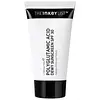What's inside
What's inside
 Key Ingredients
Key Ingredients

 Benefits
Benefits

 Concerns
Concerns

 Ingredients Side-by-side
Ingredients Side-by-side

Water
Skin ConditioningCetearyl Alcohol
EmollientPotassium Thioglycolate
Urea
BufferingCeteareth-20
CleansingGlyceryl Stearate
EmollientIsopropyl Myristate
EmollientCalcium Hydroxide
BufferingGlycerin
HumectantParfum
MaskingSodium Hydroxide
BufferingMagnesium Aluminum Silicate
AbsorbentSodium Gluconate
Skin ConditioningHelianthus Annuus Seed Oil
EmollientAloe Barbadensis Leaf Extract
EmollientIron Oxides
Water
Skin ConditioningOctocrylene
UV AbsorberGlycerin
HumectantEthylhexyl Salicylate
UV AbsorberCoco-Caprylate/Caprate
EmollientButyl Methoxydibenzoylmethane
UV AbsorberPhenylbenzimidazole Sulfonic Acid
UV AbsorberTriheptanoin
Skin ConditioningSaccharomyces Ferment
Skin ConditioningCetearyl Alcohol
EmollientGlyceryl Stearate Se
EmulsifyingTromethamine
BufferingGlyceryl Caprylate
EmollientPropanediol
SolventC9-12 Alkane
SolventDilinoleic Acid/Butanediol Copolymer
Sodium Stearoyl Glutamate
CleansingHydroxyethyl Acrylate/Sodium Acryloyldimethyl Taurate Copolymer
Emulsion StabilisingDimethicone
EmollientSqualane
EmollientHectorite
AbsorbentLauroyl Lysine
Skin ConditioningHydroxyethylcellulose
Emulsion StabilisingCaprylhydroxamic Acid
Dimethiconol
EmollientPolysorbate 60
EmulsifyingAcrylates/C10-30 Alkyl Acrylate Crosspolymer
Emulsion StabilisingOryza Sativa Hull Extract
MoisturisingCastor Oil/Ipdi Copolymer
Phenoxyethanol
PreservativePolyglutamic Acid
Skin ConditioningSorbitan Isostearate
EmulsifyingCamellia Sinensis Leaf Extract
AntimicrobialIpomoea Batatas Root Extract
Skin ConditioningHydroxyacetophenone
AntioxidantSodium Benzoate
Masking1,2-Hexanediol
Skin ConditioningCaprylyl Glycol
EmollientLactobacillus Ferment Lysate
Skin ConditioningSaccharomyces Lysate
Skin ConditioningWater, Octocrylene, Glycerin, Ethylhexyl Salicylate, Coco-Caprylate/Caprate, Butyl Methoxydibenzoylmethane, Phenylbenzimidazole Sulfonic Acid, Triheptanoin, Saccharomyces Ferment, Cetearyl Alcohol, Glyceryl Stearate Se, Tromethamine, Glyceryl Caprylate, Propanediol, C9-12 Alkane, Dilinoleic Acid/Butanediol Copolymer, Sodium Stearoyl Glutamate, Hydroxyethyl Acrylate/Sodium Acryloyldimethyl Taurate Copolymer, Dimethicone, Squalane, Hectorite, Lauroyl Lysine, Hydroxyethylcellulose, Caprylhydroxamic Acid, Dimethiconol, Polysorbate 60, Acrylates/C10-30 Alkyl Acrylate Crosspolymer, Oryza Sativa Hull Extract, Castor Oil/Ipdi Copolymer, Phenoxyethanol, Polyglutamic Acid, Sorbitan Isostearate, Camellia Sinensis Leaf Extract, Ipomoea Batatas Root Extract, Hydroxyacetophenone, Sodium Benzoate, 1,2-Hexanediol, Caprylyl Glycol, Lactobacillus Ferment Lysate, Saccharomyces Lysate
 Reviews
Reviews

Ingredients Explained
These ingredients are found in both products.
Ingredients higher up in an ingredient list are typically present in a larger amount.
Cetearyl alcohol is a mixture of two fatty alcohols: cetyl alcohol and stearyl alcohol. It is mainly used as an emulsifier. Emulsifiers help prevent the separation of oils and products. Due to its composition, it can also be used to thicken a product or help create foam.
Cetearyl alcohol is an emollient. Emollients help soothe and hydrate the skin by trapping moisture.
Studies show Cetearyl alcohol is non-toxic and non-irritating. The FDA allows products labeled "alcohol-free" to have fatty alcohols.
This ingredient is usually derived from plant oils such as palm, vegetable, or coconut oils. There is debate on whether this ingredient will cause acne.
Due to the fatty acid base, this ingredient may not be Malassezia folliculitis safe.
Learn more about Cetearyl AlcoholGlycerin is already naturally found in your skin. It helps moisturize and protect your skin.
A study from 2016 found glycerin to be more effective as a humectant than AHAs and hyaluronic acid.
As a humectant, it helps the skin stay hydrated by pulling moisture to your skin. The low molecular weight of glycerin allows it to pull moisture into the deeper layers of your skin.
Hydrated skin improves your skin barrier; Your skin barrier helps protect against irritants and bacteria.
Glycerin has also been found to have antimicrobial and antiviral properties. Due to these properties, glycerin is often used in wound and burn treatments.
In cosmetics, glycerin is usually derived from plants such as soybean or palm. However, it can also be sourced from animals, such as tallow or animal fat.
This ingredient is organic, colorless, odorless, and non-toxic.
Glycerin is the name for this ingredient in American English. British English uses Glycerol/Glycerine.
Learn more about GlycerinWater. It's the most common cosmetic ingredient of all. You'll usually see it at the top of ingredient lists, meaning that it makes up the largest part of the product.
So why is it so popular? Water most often acts as a solvent - this means that it helps dissolve other ingredients into the formulation.
You'll also recognize water as that liquid we all need to stay alive. If you see this, drink a glass of water. Stay hydrated!
Learn more about Water